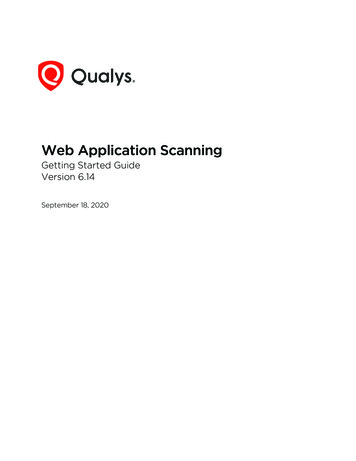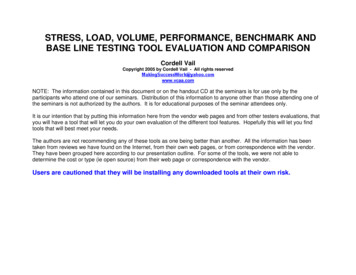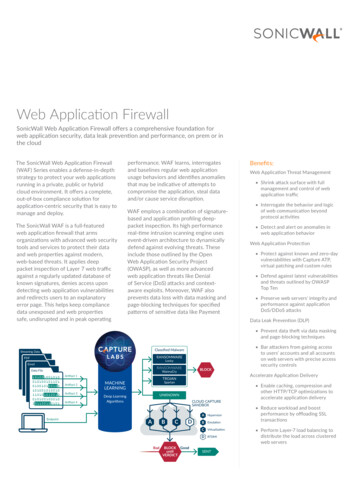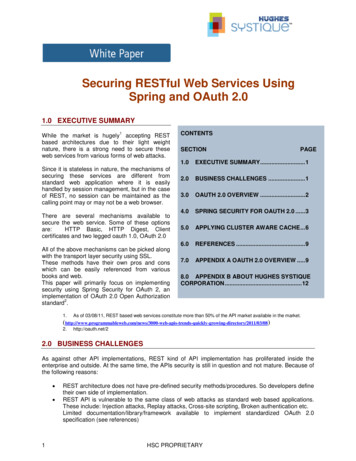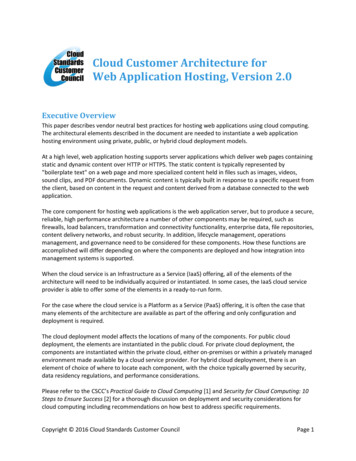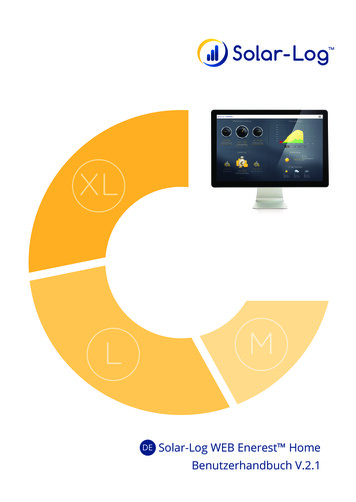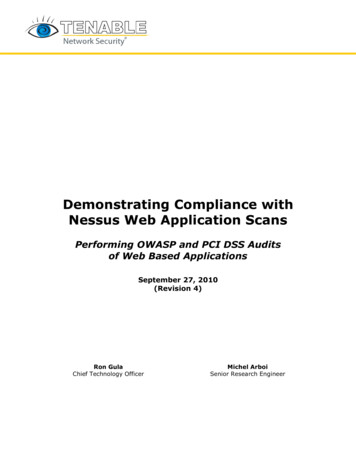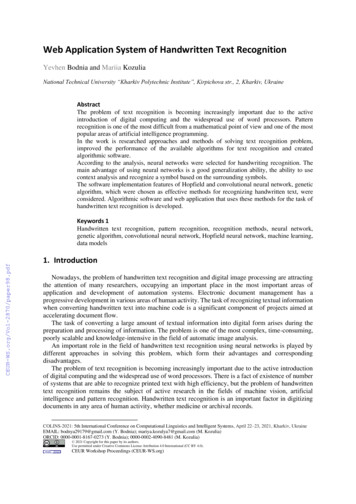
Transcription
Web Application System of Handwritten Text RecognitionYevhen Bodnia and Mariia KozuliaNational Technical University “Kharkiv Polytechnic Institute”, Kirpichova str., 2, Kharkiv, UkraineAbstractThe problem of text recognition is becoming increasingly important due to the activeintroduction of digital computing and the widespread use of word processors. Patternrecognition is one of the most difficult from a mathematical point of view and one of the mostpopular areas of artificial intelligence programming.In the work is researched approaches and methods of solving text recognition problem,improved the performance of the available algorithms for text recognition and createdalgorithmic software.According to the analysis, neural networks were selected for handwriting recognition. Themain advantage of using neural networks is a good generalization ability, the ability to usecontext analysis and recognize a symbol based on the surrounding symbols.The software implementation features of Hopfield and convolutional neural network, geneticalgorithm, which were chosen as effective methods for recognizing handwritten text, wereconsidered. Algorithmic software and web application that uses these methods for the task ofhandwritten text recognition is developed.Keywords 1Handwritten text recognition, pattern recognition, recognition methods, neural network,genetic algorithm, convolutional neural network, Hopfield neural network, machine learning,data models1. IntroductionNowadays, the problem of handwritten text recognition and digital image processing are attractingthe attention of many researchers, occupying an important place in the most important areas ofapplication and development of automation systems. Electronic document management has aprogressive development in various areas of human activity. The task of recognizing textual informationwhen converting handwritten text into machine code is a significant component of projects aimed ataccelerating document flow.The task of converting a large amount of textual information into digital form arises during thepreparation and processing of information. The problem is one of the most complex, time-consuming,poorly scalable and knowledge-intensive in the field of automatic image analysis.An important role in the field of handwritten text recognition using neural networks is played bydifferent approaches in solving this problem, which form their advantages and correspondingdisadvantages.The problem of text recognition is becoming increasingly important due to the active introductionof digital computing and the widespread use of word processors. There is a fact of existence of numberof systems that are able to recognize printed text with high efficiency, but the problem of handwrittentext recognition remains the subject of active research in the fields of machine vision, artificialintelligence and pattern recognition. Handwritten text recognition is an important factor in digitizingdocuments in any area of human activity, whether medicine or archival records.COLINS-2021: 5th International Conference on Computational Linguistics and Intelligent Systems, April 22–23, 2021, Kharkiv, UkraineEMAIL: bodnya29179@gmail.com (Y. Bodnia); mariya.kozulya7@gmail.com (M. Kozulia)ORCID: 0000-0001-8167-0273 (Y. Bodnia); 0000-0002-4090-8481 (M. Kozulia) ️ 2021 Copyright for this paper by its authors.Use permitted under Creative Commons License Attribution 4.0 International (CC BY 4.0).CEUR Workshop Proceedings (CEUR-WS.org)
In recent decades, thanks to the use of modern computer technology, new methods of imageprocessing and pattern recognition have been developed, making it possible to create such handwritingrecognition systems that would meet the basic requirements of document automation systems.However, this task requires further research due to the specific requirements for speed, resolution,recognition reliability and memory capacity.Thus, the research aim is to compare the approaches and methods of handwriting recognition andsoftware development.The main methods of handwritten text recognition, disadvantages and advantages of the mostpromising ones are analyzed in the work, algorithmic software is developed, the software product withthe possibility of pattern recognition is implemented.2. Literature reviewWork on handwritten text recognition began in 1929 and continues to this day [1, 2, 3, 4 pp. 25–27,5, 6]. Currently, there are many software products aimed at automating the process of recognizingprinted text in enterprises. But the important thing is that they all focus on working with printed orhandprinted texts. Significant progress has been made in the recognition of handwritten texts in variousfonts and languages. There are a lot of products that are leaders in this field: Google Lens, Google Input,ABBYY FineReader, FormXtra Capture, CuneiForm and others. Also, many systems are successfullyengaged in the recognition of dynamic handwriting input into the reader (online-recognition). At thesame time, the issue of static handwritten text recognition (offline recognition) is still unresolved. Theaccuracy of technologies in this area is too low for widespread use, which makes this topic relevant andpromising for research [4, pp. 27–31].In Chanchikova E. publications [7] and [8] convolutional neural networks are considered, whichallow to eliminate the shortcomings of fully connected neural networks in the recognition ofhandwritten symbols. It is necessary to use a multi-module recognition system that uses convolutionalnetworks to solve this problem.Knyazev A. [9, 10, 11, 12, 13] considers the recognition problems of continuously writtenhandwritten text, as well as discusses different approaches in solving this problem, the advantages anddisadvantages of these approaches. A combined approach to the recognition of a completely writtenhandwritten word was also presented, which includes a partition procedure based on the analysis of theword structure and a recognition procedure based on neural network usage.The publication of Popova V. [14] considers the problem of text recognition based on keywordsusing neural networks.Among foreign researchers Yugandhar Manchala [15], Thomas Deselaers [16], Henry A. Rowley[17], Hazem M El-Bakry [18] considered the recognition of handwritten symbols using artificial orrecurrent neural networks, and Ali Nosary [19], Martin Rajnoha [20] describe the recognition based onthe method of k-near neighbors and reference vector machines.According to the analysis of the subject area in the work the following tasks are set: Consideration of the processes of segmentation, normalization and selection of features Introduction to handwritten text recognition algorithms Introduction to methods and problems of handwritten text recognition Consideration of existing handwritten text recognition systems Implementation of the project description and algorithms for recognition system Identification of functional and non-functional capabilities, as well as the main modes ofoperation of the handwritten text recognition system Development algorithmic and software support of handwritten text recognition system3. Problems, tasks and methods of handwritten text recognition systemPattern recognition is one of the most difficult from a mathematical point of view and one of themost popular areas of artificial intelligence programming. Image recognition systems have foundapplication in many applications of artificial intelligence [21].
Image recognition technologies include pattern, optical image, code, object, and digital photorecognition. They are either used separately or in an integrated form in areas such as security andsurveillance, image scanning and creation, marketing and advertising, augmented reality and imageretrieval.The key driver of this market is the care of all processes, both in business and in the consumersegment of cloud technologies, as well as the growing influence of the Internet, smartphones, socialmedia. The players in this market are such large corporations as NEC, Google, Honeywell, Hitachi andQualcomm. There are also many smaller players, such as LTU Technologies, Attrasoft, Blippar andSLYCE, and vendors such as Catchoom and Wikitude [22, 23, 24].Currently, there are a lot of software applications that require text recognition functionality. Softwaredevelopers of artificial intelligence systems are faced with the task of increasing the versatility of thetasks performed by the software application. More and more attention is paid to multilayer neuralnetworks with a high degree of learning and genetic algorithms, but there is a problem of taskscomputational complexity.The system provides graphic and structural information of the input images in the task of handwrittentext recognition. The list of problems with handwritten text recognition are: High variability of characters – by size, inclination, components set, relationships betweenthem, etc. Spelling errors in the text Specific features of text writing that do not allow you to confidently separate handwrittencharacters Text elements intersection, overlapping text parts on each other Blots, stains, media (paper) defects, and scanning artifacts Non-parallel text lines [25 pp. 1, 2]Currently, commercial handwritten text recognition packages can only reliably recognize machinereadable forms (questionnaires, completed forms, etc.), because using such structured documents andreducing the range of possible characters that entered the quality of recognition increases sharply. Thiscase includes the recognition of postal addresses in the automatic sorting of mail, signatures on checks,numbers, etc. Standard handwritten text recognition is performed according to the following scheme: Pre-processing of the image, interest (features) area selection Segmentation and normalization of the text from the area of interest Recognition of segmented text by the selected method [25 p. 2]The task of the system is to increase the speed and quality of input information recognition in orderto automate this process, as well as to determine and use the most optimal method of handwritten textrecognition using neural networks.A typical handwritten text recognition scheme consists of the following main stages: pre-processingof the input image, segmentation, obtaining image features, classification and post-processing.The text recognition system receives the written handwritten text as input when receiving the image.The image should be in JPEG format.Preprocessing is a series of operations performed on an input image. This greatly improves it,making it suitable for the segmentation process. The binarization process converts a black-and-whiteimage into a binary image using a global threshold determination technique. Expanding the edges in abinary image is done by expanding the image and filling in its blank areas. The image pre-processingalgorithm is presented in Figure 1 [26].Segmentation is the most important process in text recognition methods. Segmentation is performedto divide the image into individual characters. Segmentation of the handwritten word into differentzones (upper, middle and lower) and symbols is more complicated than in printed documents.Sometimes the components of two consecutive characters can be hooked or overlapped, and thissituation greatly complicates the segmentation task.The complexity is explained by the variability of the distances between the characters, skew, tilt,size of letters and symbols, depending on the handwriting. Obtaining these characteristics is calledfeatures selection step.Segmentation is an important step in determining the degree to which words, lines, or symbols canbe separated and, as a result, directly affects the speed of handwritten text recognition.
Figure 1: Image pre-processing algorithm [26]The classification step is part of the decision making in the handwritten text recognition system. Thegenetic algorithm, the method of convolutional neural networks, the Hopfield network are used forclassification.The post-processing step is the final stage of the handwritten text recognition system. At this step,the recognized handwritten characters are displayed in a structured text form by calculating anequivalent value using the text pattern recognition index.Recognition image task is to determine the object or any of its properties by its visual representation.The technique of assigning an element to any image is called a decisive rule.Learning is a process as a result of which the system gradually acquires the ability to respond to therequired responses to certain sets of external influences, and adaptation is the adjustment of parametersand structure of the system to achieve the required quality of management in continuous changes inexternal conditions [27 p. 15].The pattern recognition methods used in the research are considered below.1. Genetic algorithm is a heuristic search algorithm that is used to solve optimization and modelingproblems by random selection, combination and variation of the required parameters using mechanismssimilar to natural selection in nature. [28]. The genetic algorithm is slower and is characterized by astepwise improvement of the error [29 p. 516, 30, 31].The block diagram of genetic algorithm is presented in Figure 2.Figure 2: Structured scheme of the genetic algorithmThe genetic algorithm effectively uses the information accumulated in the process of evolution. Inthe process of finding a solution, it is necessary to maintain a balance between the “operation” of thecurrently obtained best solutions and the expansion of the search space.Genetic algorithms show slightly lower performance than convolutional neural networks in patternrecognition problems [32, 33, 34, 35], but have excellent calculation accuracy.2. Convolutional neural network is a special architecture of artificial neural networks, proposedby Yann LeCun in 1988 and aimed at effective pattern recognition, is part of deep learningtechnologies [36, 42]. The idea of convolutional neural networks is to alternate convolution layers andsubsampling layers (or pooling layers). The structure of the network is unidirectional (withoutfeedback), multilayer (Figure 3) [38 p. 275].
Figure 3: Convolutional neural network structureA systematic approach to image processing based on the structural decomposition of theconvolutional neural network (Figure 4, 5) is used in the research [39].Figure 4: Algorithm for handwritten character recognition by neural network (author development)
Figure 5: Algorithm for handwritten character recognition by neural network (author development)Convolutional neural networks combine three architectural ideas to provide invariance for scaling,shift rotation, and spatial distortion: Local receptor fields (provide local two-dimensional connectivity of neurons) Total synapse weights (provide detection of some features anywhere in the image and reducethe total number of weights) Hierarchical organization with spatial subsamples [40 p. 47]The structure of the convolutional neural network consists of different layer types: convolutionallayers, subsampling layers, and layers of the “normal” neural network – the perceptron.The first two types of layers (convolutional, subsampling), alternating with each other, form theinput feature vector for the multilayer perceptron.The topology of the convolutional neural network consists of 5 layers (Figure 6).
Figure 6: Convolutional neural network topology [41]The sigmoid activation function belongs to the class of continuous functions and takes an arbitraryreal number at the input and gives a real number at the output in the range from 0 to 1. Large (modulo)negative numbers are converted to zero, and large positive – to one. Historically, the sigmoid has beenwidely used because its output is well interpreted as the level of neuronal activation: from lack ofactivation (0) to fully saturated activation (1).The sigmoid is represented by formula:1(1)𝑓(𝑠) . 𝑠1 𝑒The disadvantage of the sigmoid is that when the saturation of the function on one side or another(0 or 1), the gradient in these areas becomes close to zero. Sigmoidal function is continuous,monotonically increasing and differentiated [41].The disadvantages of convolutional neural networks are: High complexity of architecture Fully connected Fixed window area of the convolution layerIt is necessary to find the optimal values of the following parameters in order to increase theefficiency of convolutional neural networks: Number of feature maps Density of connections between feature maps Window size Floor area Initial initialization of weights [38 p. 275]A simple automaton that converts the input signals into the resulting output signal is shown inFigure 7.Input signals x1 , x2 , x3 , , xn are converted in a linear manner, i.e., the body of the neuron receivesweights: w1 x1 , w2 x2 , w3 x3 , , wn xn , where wi – the weights of the corresponding signals.The neuron summarizes these signals, then applies the sum of the sigmoid function f(x) and outputs theresulting output signal y.
Figure 7: Scheme of a mathematical neuron3. Hopfield neural network is a type of recurrent, fully connected, artificial neural network with asymmetric matrix of connections. In the process, the dynamics of such networks converges to one ofthe equilibrium positions. Equilibrium positions are determined in advance in the learning process, theyare the local minimum of the functional, which is called the network energy. Such network can be usedas auto-associative memory, as a filter, as well as for optimization problems. Unlike many neuralnetworks that work to get a response through a certain number of cycles, Hopfield networks work toachieve equilibrium, when the next state of the network is exactly equal to the previous one: the initialstate is the input image, and at equilibrium get the original image [42 p. 37, 43].These equilibrium positions are local minimum of functional called network energy (local minimumof a negatively defined quadratic shape on an n-dimensional cube). Such network can be used as autoassociative memory, as a filter, and to solve some optimization problems. Unlike many neural networksthat work to receive a response through a certain number of cycles, Hopfield networks work to reachequilibrium, when the next network state is equal to the previous one [44].The Hopfield network uses three layers: the input layer, the Hopfield layer, and the output layer.Each layer has the same number of neurons. The inputs of the Hopfield layer are connected to theoutputs of the corresponding neurons of the input layer via variable connection weights. The outputs ofthe Hopfield layer are connected to the inputs of all neurons in the Hopfield layer, except itself, as wellas to the corresponding elements in the output layer. In operation mode, the network directs data fromthe input layer through fixed connection weights to the Hopfield layer. The Hopfield layer oscillatesuntil a certain number of cycles is completed, and the current state of the layer is transmitted to theoriginal layer. This state corresponds to an already programmed image in network [42 p. 38].Learning the Hopfield network requires that the learning image be presented in the input and outputlayers at the same time. The recursive nature of the Hopfield layer provides a means of correcting allthe weights of the joints. The non-binary implementation of the network should have a thresholdmechanism in the transfer function. The corresponding input-output pairs should be different for propernetwork training.The Hopfield neural network response to the successful registration of m-reference images is madeup of these images themselves. The Hopfield network corrects errors and obstacles (Figure 8).Figure 8: Block diagram of the Hopfield network with three neurons
If the Hopfield network is used as memory addressed to content, it has two main limitations. First,the number of images that can be saved and accurately reproduced is strictly limited. If too manysettings are stored, the network may match to a new non-existent image that is different from allprogrammed images or may not match at all. The memory capacity limit for the network isapproximately 15 % of the neurons number in the Hopfield layer. The second limitation of the paradigmis that the Hopfield layer can become unstable if the case studies are too similar. An image sample isconsidered unstable if it is applied in zero time and the network coincides with some other image fromthe training set. This problem can be solved by choosing learning examples more orthogonal to eachother [42 p. 38].The problem solved by this network as associative memory, as a rule, is formulated as follows. Someset of binary signals (input handwritten image) is known, considering it exemplary. The network shouldbe able to isolate the appropriate sample from the noisy signal supplied to its input or to conclude thatthe input data does not match any of the samples. In the General case, any signal can be described bythe vector 𝑥1 , 𝑥2 , , 𝑥𝑖 , , 𝑥𝑛 , where n – the number of neurons in the network and the magnitude ofthe input and output vectors. Each element 𝑥𝑖 is equal to either 1 or –1. Denote the vector describingthe k-th sample by 𝑋𝑘 and its components, respectively, – 𝑥𝑖𝑘 , 𝑘 0, ., 𝑚 1, m – the number ofsamples. If the network recognizes a pattern based on the data presented to it, its outputs will containit, i.e. 𝑌 𝑋𝑘 , where Y – the vector of the initial values of the network: 𝑦1 , 𝑦2 , , 𝑦𝑖 , , 𝑦𝑛 . Otherwise,the original vector will not match any of the samples.Thus, the choice of the considered methods is based on the following characteristics of the methods: Clear definition of the contours and boundaries of handwritten characters Analysis of a given area for the presence of characteristic points, gradients in it, allowing youto recognize an image in difficult and atypical conditions The ability to recognize various forms of tracing, tilt and distortion (noise, non-uniformity oflighting, displacement of characters, gaps between parts of the same character, false signs) characters Fixing the offset of characters or parts of characters relative to their expected position in thestring Ease of implementation Resistance to changes in the shape of characters High performance No loss of part of the information about the symbol at the stage of feature extraction The presence of clearly formulated rules for the formation of signsThe advantages of recognition methods include invariance with respect to types and sizes of fonts,identification of characters that have defects (for example, line breaks or merging of adjacent lines), aswell as high performance.The main advantage of using neural networks is a good generalization ability, the ability to usecontext analysis and recognize a symbol based on the surrounding symbols.The recognition accuracy using these methods in the system is approximately 96%.4. Practical implementation. Software system designThe handwritten text recognition software system is developed in the form of a web application“TextRecognition”. This application is designed to provide the user with the function of recognizingthe entered handwritten text and further work with the entered data. The core of the text recognitionsystem will be artificial neural networks. Calculations and training of neural networks will take placeon the server side and the client part will give the user the opportunity to use the capabilities of a trainedneural network for text recognition.The IDEF0 diagram of the handwritten text recognition process is shown in Figure 9.The user-entered data for neural network training, namely, the results of the comparison of theentered handwritten character and the character from the set available in the application, will be storedin the database. The database will be isolated from direct unauthorized actions.
Figure 9: Decomposed IDEF0 diagram of handwriting recognition processThe use of the web application extends to all countries. The application is designed for handwrittentext recognition in Ukrainian. The web application applies to all users and works in all popular webbrowsers. The application uses a minimalist user-friendly interface that is intuitive for the user.Functions that are implemented in the presented software application: Create, view, modify character mapping data for neural network training Providing access to the web application via the Internet Neural network training Neural network configuration Recognition of handwritten Ukrainian textThe web application should allow the user to map the entered character to the character from thedatabase in order to learn neural networks in detail.The web application is based on HTML 5.0, SCSS, Vue.js framework, TypeScript language, Node.jsplatform and Tesseract.js library.The user interface of the “TextRecognition” software application consists of the following threepages:1. Recognition – the home page with the ability to recognize handwritten text2. Training – the page with the ability to learn neural networks3. Settings – the page with the ability to configure neural networks5. Development of testing software solution programThe following tests were performed to test the problem solutions: Entering a compressed handwritten word Entering a handwritten word at an angle Entering a handwritten word in the form of a wave (Figure 10–12)The neural network was trained to recognize each letter of the Ukrainian alphabet with a differenttype of handwriting.
Figure 10: Entering the handwritten words in the wave form for recognition using genetic algorithmsFigure 11: Entering the handwritten words in the wave form for recognition using convolutional neuralnetwork
Figure 12: Entering the handwritten words in the wave form for recognition using Hopfield neuralnetworkAs a numerical experiment, handwritten text was entered to verify the cost of time resources by therecognition application. As a result, existing solutions were compared with the developed webapplication [45, 46, 47]. The results are summarized in Table 1.Table 1Cost of time resources for handwritten text recognitionName of software solutionGoogle Handwriting InputABBYY FineReaderOCR CuneiFormTextRecognitionGenetic algorithmConvolutional neural networkHopfield neural networkCost of time resources, s a result of testing the solutions of the problem, we can conclude that the application has theability to recognize handwritten text in its various positions. Composing the indicators of quality andspeed of recognition, it can be argued that the most optimal recognition of the Ukrainian handwrittentest is carried out using convolutional neural networks. Handwritten text recognition quality can beimproved by learning neural networks in more detail.The application is a handwritten text recognition system that includes feature selection andsegmentation subsystems. Improvements and enhancements to the functionality of the application areplanned in its next versions.6. ConclusionsOptical handwritten text recognition is a handy tool for creating digital documents from paperoriginals. Text representation allows further processing of information obtained by scanning or
photographing. The relevance of text recognition has increased with the advent of e-book readers,making the reading process easier. Optical recognition has greatly facilitated the document flowprocess.Based on the analysis of the subject area and the considered methods for solving the problem ofhandwritten text recognition, it was found that the speed and quality of this subsystem meets modernrequirements.Effective solutions to the problem are demonstrated using genetic algorithms, convolutional neuralnetworks and Hopfield neural networks (see Figure 2–8).Algorithmic approaches that characterize the work of the considered methods are developed (seeFigure 4–5). UML diagrams are created to describe the operation of the system, which demonstrate thepossible cases and operation of the main processes of the implemented software (see Figure 9).The presence of many existing libraries based on the JavaScript programming language emphasizesthe development of handwritten text recognition systems in software engineering, which accelerates thesoftware development process to automate the task in this work.The developed application can be used as a system for recognizing Ukrainian handwritten texts (seeFigure 10–12).The software solution used a stack of technologies – HTML5, SCSS, Node.js, Express.js,MongoDB, Mongoose, Vue.js – which is an integral part of web application development. High-speedsoftware was created based on neural networks and genetic algorithms, which in turn has a higherpriority in modern research in this field of science.Improvements and enhancements to the functionality of the application are planned in its nextversions. The application will be expanded, namely the recognition of handwritten text entered by theuser in English and Russian.7. References[1] Multimedia Technology IV: Proceedings of the 4th International Conference on MultimediaTechnology, Sydney, Australia, 28-30 March 2015., CRC Press, 2015., 214 p.[2] Gustav Tauschek Reading Machine: USA patent 2,026,329, Application May 27, 1929, SN366,466 in Austria., Patented Dec. 31, 1935 in US Patent Office.[3] P.W. Handel Statistical Machine: USA patent 1,915,993. Filed April 27, 1931. Patented June 27,1933 in US Patent Office.[4] Yelisieieva S. V. Information Technologies in Translation: A Study Guide. Мykolaiv: PMBSNUPublishing House, 2018, 176 р. URL: nologies%20in%20Translation.pdf.[5] Optical character recognition, 2021. URL: https://en.wikipedia.org/wiki/Optical char
Pattern recognition is one of the most difficult from a mathematical point of view and one of the most popular areas of artificial intelligence programming. Image recognition systems have found application in many applications of artificial intelligence [21]. Image recognition technologies include
